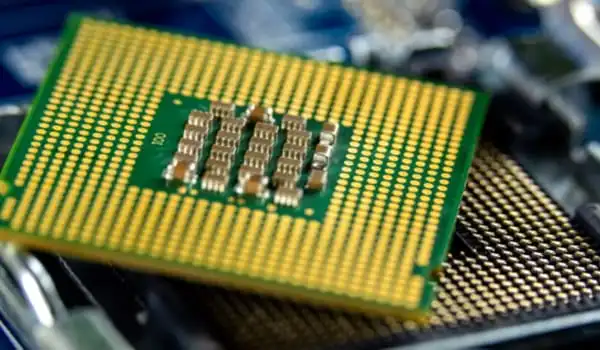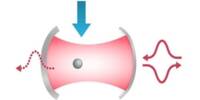A team of researchers created an ultrathin silicon nanowire that conducts heat 150 percent more efficiently than traditional materials used in advanced chip technologies. The device could allow for smaller, faster, and more energy-efficient microelectronics. Researchers have developed a new material that conducts heat 150 percent more efficiently than conventional materials used in advanced chip technologies.
The device, an ultrathin silicon nanowire, has the potential to enable smaller, faster microelectronics with heat-transfer efficiency that exceeds current technologies. Electronic devices powered by microchips that efficiently dissipate heat would consume less energy, potentially helping to mitigate the consumption of energy produced by burning carbon-rich fossil fuels, which has contributed to global warming.
“By overcoming silicon’s natural limitations in its capacity to conduct heat, our discovery tackles a hurdle in microchip engineering,” said Junqiao Wu, the scientist who led the Physical Review Letters study reporting the new device. Wu is a faculty scientist in the Materials Sciences Division and professor of materials science and engineering at UC Berkeley.
Heat’s slow flow through silicon
Because silicon, the material of choice for computer chips, is cheap and plentiful, our electronics are relatively inexpensive. However, while silicon is a good conductor of electricity, it is not a good conductor of heat when reduced to very small sizes – and this presents a significant problem for tiny microchips when it comes to fast computing.
Tens of billions of silicon transistors reside within each microchip, directing the flow of electrons in and out of memory cells, encoding bits of data as ones and zeroes, the binary language of computers. Electrical currents flow between these hardworking transistors, and these currents invariably generate heat.
Heat flows naturally from a hot object to a cool object. However, heat flow in silicon becomes complicated. Silicon is composed of three different isotopes in its natural state, which are chemical elements with an equal number of protons but a different number of neutrons (hence different mass) in their nuclei.
According to co-author Joel Ager, who is a senior scientist in Berkeley Lab’s Materials Sciences Division and an adjunct professor of materials science and engineering at UC Berkeley, about 92 percent of silicon is silicon-28, which has 14 protons and 14 neutrons; about 5 percent is silicon-29, which has 14 protons and 15 neutrons; and only 3 percent is silicon-30, a relative heavyweight with 14 protons and 16 neutrons.
When phonons, the waves of atomic vibration that carry heat, wind their way through the crystalline structure of silicon, their direction changes when they come into contact with silicon-29 or silicon-30, whose different atomic masses “confuse” the phonons and slow them down.
“The phonons eventually get the idea and find their way to the cold end to cool the silicon material,” Ager said, “but this indirect path allows waste heat to build up, which also slows down your computer.”
By overcoming silicon’s natural limitations in its capacity to conduct heat, our discovery tackles a hurdle in microchip engineering. The phonons eventually get the idea and find their way to the cold end to cool the silicon material but this indirect path allows waste heat to build up, which also slows down your computer.
Junqiao Wu
A big step toward faster, denser microelectronics
For decades, researchers hypothesized that chips made of pure silicon-28 would overcome silicon’s thermal conductivity limit, improving the processing speeds of smaller, denser microelectronics. Purifying silicon down to a single isotope, on the other hand, necessitates high levels of energy, which few facilities can provide – and even fewer specialize in producing market-ready isotopes, according to Ager.
This sparked a series of groundbreaking experiments, including a 2006 study published in Nature in which Ager and Haller fashioned silicon-28 into single crystals, which they used to demonstrate quantum memory storing information as quantum bits or qubits, units of data stored simultaneously as a one and a zero in an electron’s spin.
Following that, semiconducting thin films and single crystals made with Ager’s and Haller’s silicon isotope material were shown to have 10% higher thermal conductivity than natural silicon – an improvement, but probably not enough to justify spending a thousand times more money to build a computer from isotopically pure silicon, according to Ager.
But Ager recognized that the silicon isotope materials had scientific significance beyond quantum computing. So he stored what remained in a secure location at Berkeley Lab in case other scientists needed it, reasoning that few people have the resources to make or even purchase isotopically pure silicon.

A path toward cooler tech with silicon-28
Wu and his graduate student Penghong Ci were looking for new ways to improve the heat transfer rate in silicon chips about three years ago.
One method for producing more efficient transistors is to use a type of nanowire known as a Gate-All-Around Field Effect Transistor. According to Wu, silicon nanowires are stacked in these devices to conduct electricity while also producing heat. “And if the heat generated is not quickly extracted out, the device will stop working, similar to a fire alarm blaring in a tall building with no evacuation map,” he explained.
However, heat transport is even worse in silicon nanowires because their rough surfaces – scars from chemical processing – scatter or “confuse” the phonons even more, he explained. “And then one day we wondered, ‘What would happen if we made a nanowire from isotopically pure silicon-28?'” Wu explained.
Silicon isotopes are difficult to obtain on the open market, and word had it that Ager still had some silicon isotope crystals in storage at Berkeley Lab — not much, but enough to share “if someone has a great idea about how to use it,” Ager said. “And Junqiao’s new study was one such case.”
A surprising big reveal with nano tests
“We’re very fortunate that Joel happened to have the isotopically enriched silicon material ready to use for the study,” Wu said.
The Wu team tested the thermal conductivity of bulk 1-millimeter-size silicon-28 crystals versus natural silicon using Ager’s silicon isotope materials, and their results confirmed what Ager and his collaborators discovered years ago: bulk silicon-28 conducts heat only 10% better than natural silicon.
Now for the nano test. Using a technique called electroless etching, Ci made natural silicon and silicon-28 nanowires just 90 nanometers (billionths of a meter) in diameter — about a thousand times thinner than a single strand of human hair.
To measure the thermal conductivity, Ci suspended each nanowire between two microheater pads outfitted with platinum electrodes and thermometers, and then applied an electrical current to the electrode to generate heat on one pad that flows to the other pad via the nanowire.
“We expected to see only a 20 percent incremental benefit from using isotopically pure material for nanowire heat conduction,” Wu said. But Ci’s stature astounded them all. The Si-28 nanowires conducted heat not by 10% or 20%, but by 1500% better than natural silicon nanowires of the same diameter and surface roughness.
Wu stated that this defied everything they had expected to see. The rough surface of a nanowire typically slows phonons. So, what exactly was going on?
The first clue was discovered in high-resolution TEM (transmission electron microscopy) images of the material captured by Matthew R. Jones and Muhua Sun at Rice University: a glass-like layer of silicon dioxide on the silicon-28 nanowire surface.















